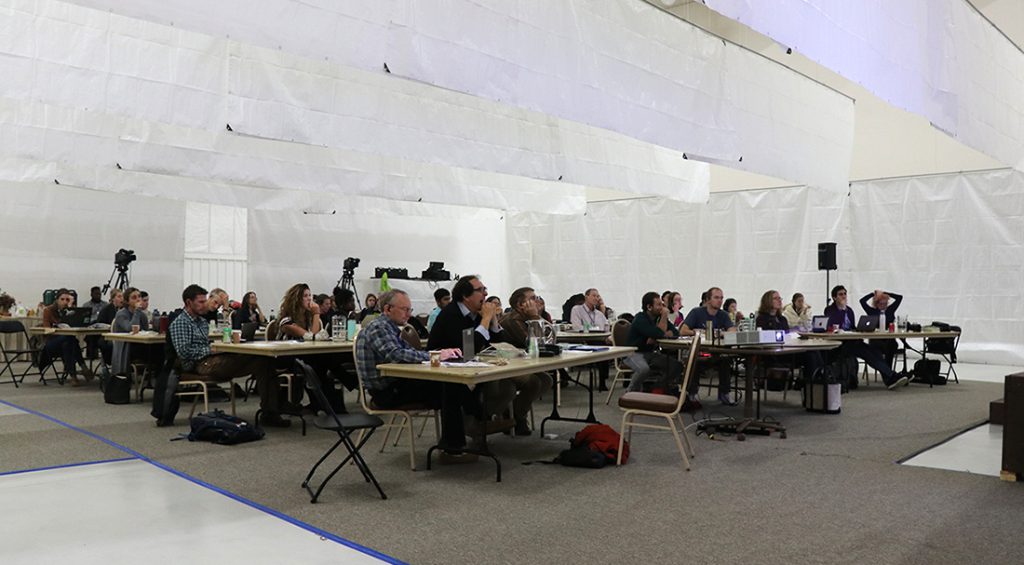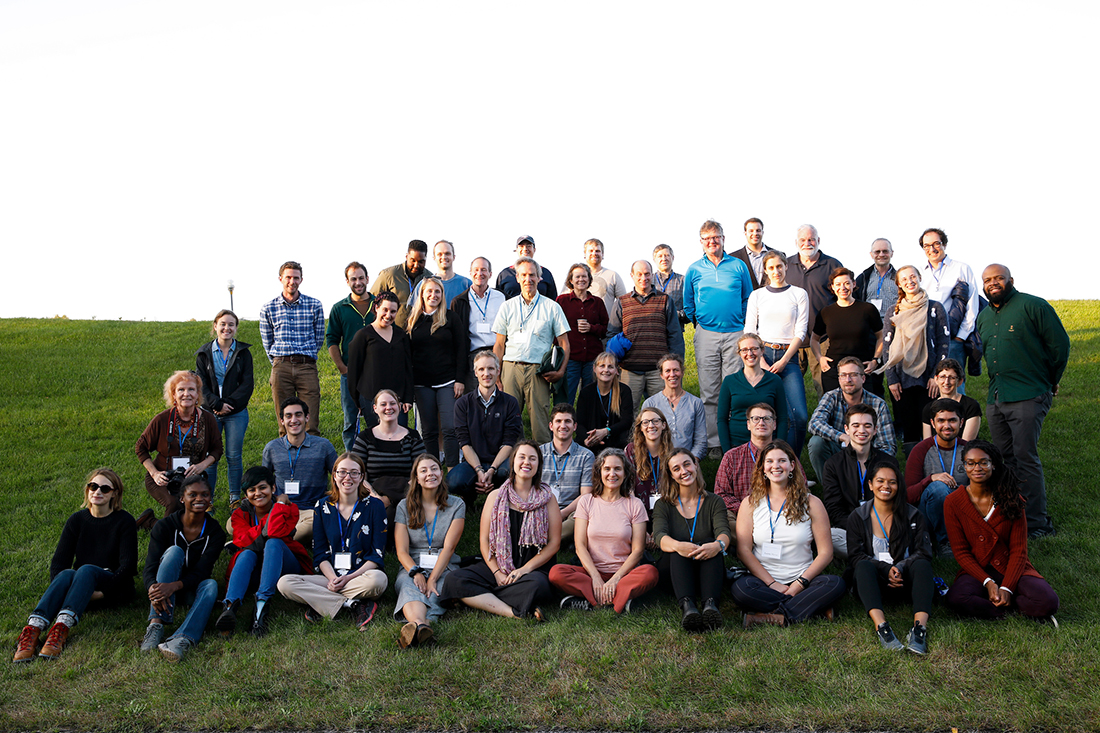By Chris McConaghey
Medill Reports
The glaciers are melting faster, accelerating sea level rise. Ocean currents are changing, altering weather and rainfall that millions of people rely on. And wind patterns are shifting as the climate heats up. These are among the global climate challenges deliberated at the annual Comer Climate Conference in southwestern Wisconsin this fall.
Veteran researchers with some of the most decorated backgrounds in climate science as well as the next generation of researchers gathered to present their findings from Nepal, the North Pacific, the Indian Ocean, and the glacial mountains of Uganda, Mongolia and Europe. They came to present findings that can help tackle the troublesome state of our planet with the urgent need to address climate change.
Many of these scientists are searching for clues from past changing climates to help us interpret the pace and impact of human-forced climate change now.

Scientists debated key questions during conference sessions in an airplane hangar and over meals under a white tent on a fall-dusted hillside. And one conclusion was unanimous: increasing CO2 levels – accelerated by the increasing use of fossil fuels by humans – is the driving factor behind our changing climate.

“If we emit a lot of CO2, and if we don’t change our energy system, we will see a lot of warming, and that really will matter to living things – including us. This is a confirmation of what we’ve suspected for a long time: that our CO2 is important,” said geoscientist Richard Alley, professor at Pennsylvania State University.
“Lazard, the world’s largest independent investment bank,…has said that if you got rid of all the subsidies for wind and sun, but you left in place all the subsidies for fossil fuels, in many places and times now in our country, wind and sun are still cheaper.” Alley said.
Alley added that Lazard puts out regular statements on what different forms of energy cost in the U.S. electric grid. With advances in energy technology, addressing climate change will make us economically better off, Alley said.
He and dozens of other scientists brought to the climate conference, inaugurated some 15 years ago, issues from all over the world. Here is an overview.
Chris McConaghey, Anne Snabes and Elena Bruess report on the retreat of glaciers in the Himalayas and social and economic impacts
Geologist Aaron Putnam, an assistant professor at the University of Maine, recently completed an expedition to the Himalayas to monitor the rapid retreat of the Khumbu Glacier, standing 24,934 feet above sea level at 28 degrees north. He and his students – including Ph.D. candidate Peter Strand and master’s student Laura Mattas – have speculated from taking core samples of boulders formerly locked in the glaciers that melting occurred rapidly as the ice retreated. Their findings will contribute to models that will help us understand what is happening to glaciers as human forcing continues.
“At some point in the past, the glacier jumped from far down the valley, up to near its’ modern configuration. The lack of well-preserved [boulder] moraines along the way indicates that the glacier didn’t slowly step back. If it did, it would have slowly deposited moraines.” Strand said. “It is that retreat that is basically unprecedented within the last glacier cycle.”
The Khumbu Glacier is also special because it has an elevation profile of around 16,400 feet to 26,240 feet, which allows researchers to sample the atmosphere at extreme heights. It remains one of the tallest glaciers in the world and escalates part way up the highest mountain on Earth – Mt. Everest. Even though Khumbu is one glacier, it can tell us more about our entire climate system as a whole.
“One of the reasons we’re interested at comparing the transitions from an Ice Age world to an interglacial world is because we’re trying to figure out how an entire [climate] system can jolt from one stable mode of operation to another stable mode of operation. A system wants to remain locked in a mode of operation, but if you keep pressuring and pushing it, you can pass a breaking point – which might not be good for us.” said Putnam.
Jeff Severinghaus, a professor of geosciences at the Scripps Institution of Oceanography at University of California, San Diego, also said that as Khumbu’s rapid recession occurs, it can create large lakes that eventually break down natural dams – made of ice or mud or a mixture of both – and flush water downriver at high speeds. The deluge causes dangerous and destructive flooding to people nearby and their homes.
The massive ice sheets in the Artic, Antarctica and Greenland are at risk as well. The melt from Greenland’s ice sheet each year is enough to “cover the states of Florida and New York in ‘hip-deep’ water, with some [water] left over,” said Allison Jacobel, a post-doctoral research fellow at Brown University, quoting Michael Bevis from a recent National Geographic article.
See Anne Snabes’ article on Khumbu Glacier offers clues to rapid retreat and Elena Bruess’ article on Rapid glacier melt near Mt. Everest peaks threatens Nepal communities.
Zack Fishman reports Brendan Reilly and the rapid melting of the Greenland ice sheet
Near the Arctic, Brendan Reilly joined other researchers on a 2015 Greenland expedition to explore the history of the Petermann Glacier, located on the frozen island’s northwest side. His team found that a narrow strip of the glacier, known as an “ice tongue,” was completely melted away from 7,000 to 2,000 years ago, contradicting the expectation that the tongue was stable and slow to change.
As the ice tongue melts, it gets thinner, and becomes more vulnerable to calving – when icebergs break off from glaciers – contributing to the melting. With another crack already expanding, major calving events are likely to continue.
“It does seem like that’s going to be the next big calving event. That calving event will again decrease the length of that ice tongue to an extent shorter than we’ve observed in historical record,” Reilly said. “The ice tongue hasn’t been this short in centuries.”
This research suggests the Petermann is now more susceptible to even faster melting in the future.
“Losing the ice tongue will increase the amount of water melt that’s coming out of that system, so that’ll be the contribution to sea level rise. Because we’ve never observed this particular system breaking up before, we don’t exactly know what’s going to happen.” said Reilly.
See Zack Fishman’s full article: Greenland ice tongue at risk of melting away again.
Madhurita Goswami reports on glaciers melting – even in the tropics
Alice Doughty, a visiting assistant geology professor at Bates College, and Meredith Kelly, an associate professor of Earth Science at Dartmouth College, talked about their research at the Rwenzori Mountains in Uganda. Doughty is involved with modelling of tropical glaciers, and Kelly collects moraine data from the sites. Because seasons don’t play a major role in glacial activity in the Tropics, the Rwenzori glaciers can provide clues about other climate players.
See full article Tropical Glaciers Are Melting Fast by Madhurita Goswami
Elena Bruess reports on Becki Beadling deploying robots to study the oceans and climate change:
Becki Beadling, a geosciences Ph.D. candidate at the University of Arizona in Tuscan, works in climate model simulations and observations to better understand how our oceans are reacting to climate change. She focuses on carbon uptake in the Southern Ocean and how it buffers atmospheric global warming due to rising carbon levels.
“Roughly 90% of the excess heat that’s trapped on our planet from greenhouse gas emissions has gone into our oceans. And the Southern Ocean is taking up the most.” Beadling said. “Heat and carbon are the most important components when thinking of the past, present and future of climate.”
Beadling also studies ocean acidification due to climate change and the way small dissolved shells help abate this growing problem for marine life. Beadling compared her extensive field observations against simulation models, a technique that scientists use to predict and understand where climate may be heading.
See Elena Bruess’ full article: 4,000 floating robots take on climate change .
Mahurita Goswami reports on Tom Lowell Comparing glaciers from around the world.
Thomas Lowell, a professor of geology at the University of Cincinnati, has compared data on glaciers from around the world and found that they act in a synchronized manner. The data he obtained used carbon-14 and beryllium-10 dating techniques and they both demonstrated the same results. His work proves at the end of the last Ice Age, all glaciers reached their maximum at the same time, even though the seasons are diametrically opposed in the Northern and Southern Hemispheres. This illustrates that heat from the sun is not the main factor causing climate change.
See Madhurita Goswami ‘s full article: Glaciers as global thermometers.
Anne Snabes reports on Kassandra Costa and ocean acidification
Kassandra Costa, a postdoctoral scholar at Woods Hole Oceanographic Institution, learned from collecting sediment from the ocean floor that calcium carbonate, a molecule that comes from the shells of small marine organisms known as zooplankton and phytoplankton, dissolves at a shallower depth in the North Pacific Ocean than scientists originally predicted. When calcium carbonate dissolves, it reduces ocean acidification.
See Anne Snabes’ full article: Tiny shells reveal clues to ocean health.
Lucia Whalen talked with Joellen Russell of the University of Arizona at Tucson about a new NOAA weather prediction system that improves severe storm forecasts and with Chicago teen Patricia Joyner, an alum of Gary Comer College Prep high school, about partnering with scientists in search of climate triggers in Mongolia. She her full articles at the links above.

